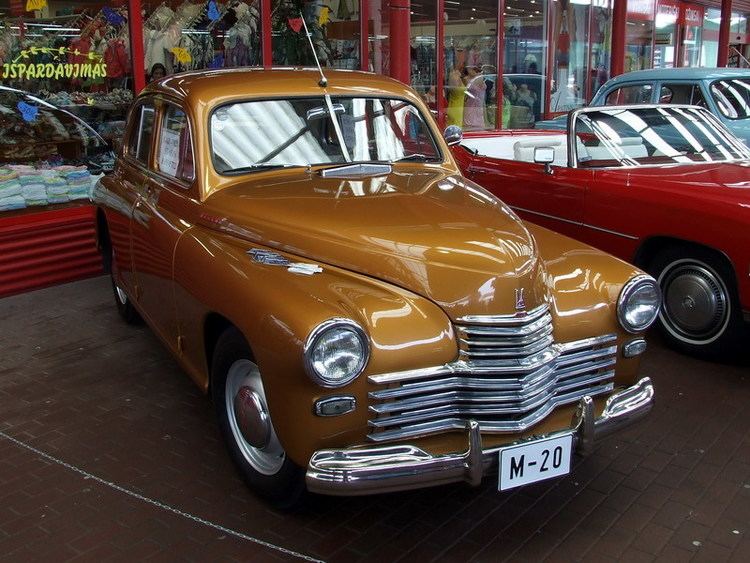 | ||
Production 1946–1958 (in Poland- until 1973) Body style 4-door sedan fastback/cabriolet | ||
The GAZ-M20 "Pobeda" (Russian: ГАЗ-М20 Победа; Победа, Victory) was a passenger car produced in the Soviet Union by GAZ from 1946 until 1958. It was also licensed to Polish Fabryka Samochodów Osobowych, as FSO Warszawa. Although usually known as the GAZ-M20, an original car's designation at that time was just M-20, for "Molotovets" (GAZ factory bore a name of Vyacheslav Molotov).
Contents
History
The first sketches of similar-looking cars were completed by Valentin Brodsky in 1938 and by Vladimir Aryamov in 1940, which revealed a growing tendency towards streamline car design in the Soviet Union. Aryamov's two-door coupe GAZ-11-80 greatly resembled the later Pobeda. The first Pobeda was developed in the Soviet Union under chief engineer Andrei A. Liphart. Originally intended to be called "Rodina" (Homeland), the name "Pobeda" (Victory) was a back-up, but was preferred by Joseph Stalin. The name was chosen because the works started in 1943 at Gorky Avto Zavod (GAZ, "Gorky Car Plant"), when victory in World War II began to seem likely, and the car was to be a model for post-war times. The plant was later heavily bombarded, but work was unaffected. Styling was done by "the imaginative and talented Veniamin Samoilov". The GAZ-M20 Pobeda was the first Soviet car not copying any foreign design and moreover introduced a new vogue in automobile design; only the front suspension and, partially, the unitized body were influenced by the 1938 Opel Kapitän. It was one of the first cars to introduce ponton styling with slab sides, preceding many Western manufacturers. The M20 was the first Soviet car using entirely domestic body dies; it was designed against wooden bucks, which suffered warping, requiring last-minute tuning by GAZ factory employees. The first prototype was ready on November 6, 1944 (for an anniversary of the October Revolution). The first production model rolled off the assembly line on June 21, 1946. It was also the first Soviet automobile to have turn signals, two electric windshield wipers (rather than mechanical- or vacuum-operated ones), four-wheel hydraulic brakes, an electric heater, and a factory-installed AM radio. The car came to be a symbol of postwar Soviet life and is today a popular collector's item.
Design and development
During the design process, GAZ had to choose between a 62 hp (46 kW; 63 PS) 2,700 cc (165 cu in) inline six and a 50 hp (37 kW; 51 PS) 2,112 cc (129 cu in) inline four; Stalin preferred the four, so it was used. In addition, the headlights were covered by an American patent.
Production started in 1946, only a year after the end of the world war, and was difficult due to serious economic and technical hardships; by the end of 1946, only twenty-three cars were completed, virtually by hand. Truly mass production had to wait until 28 April 1947, and even then, only 700 were built before October 1948. During that period the Soviet Union was unable to produce steel sheets large enough for body panels, so strips had to be welded together, which led to countless leaks and 20 kg (44 lb) of solder in the body, as well as an increase in weight of 200 kg (440 lb). Steel quality was below average, up to 60% was rejected, and the overall quality of the first cars was so low that production was actually stopped by order of the government and the company's director was fired. On August 31, 1948, the government issued a decree requiring the immediate improvement of quality and thorough testing of the new automobiles. The cars and their integral parts were subjected to detailed laboratory and on-road testing, opinions of the cars' drivers were carefully studied and taken into account.
After a reorganisation, solving the initial build quality issues, making 346 improvements and adding two thousand new tools, the Pobeda was restored to production. It had a new carburettor, different final drive ratio (5.125:1 rather than 4.7:1), strengthened rear springs, improved heater, and the ability to run on the low-grade 66 octane fuel typical in the Soviet Union. (Among the changes was a 5 cm (2.0 in) lower rear seat, enabling military and police officers to ride without removing their caps). The improvements enabled the new Pobeda to reach 50 km/h (31 mph) in 12 seconds, half the previous model's time.
The improved Pobeda was placed in production 1 November 1949, and the techniques needed to develop and manufacture it effectively created the Soviet automobile industry. In 1952, improved airflow in the engine increased power from 50 hp (37 kW; 51 PS) to 52 hp (39 kW; 53 PS); it climbed to 55 hp (41 kW; 56 PS), along with the new grille, upholstery, steering wheel, radio, and radiator badge, as the M20V (Russian: М-20В), 1955.
Versions
Total production of the Pobeda was 235,999, including 37,492 taxis and 14,222 cabriolets. A great number of cars was used by government organizations and government-owned corporations, including taxicab parks (there were no private taxis in the USSR). Despite its 16,000 ruble price tag, with average wage 800 ruble, the Pobeda was available to buy for ordinary citizens, and by 1954–1955 the demand for cars in the USSR started to exceed production, and there appeared long queues to buy a car. The Pobeda provided the first serious opportunity for the Soviet automobile industry to export cars, and "Western drivers found it to be almost indestructible".
The Pobeda was replaced by the GAZ M21 Volga.
Export
The car was a successful export for the USSR, and the design was licensed to the Polish FSO factory in Warsaw, where it was built as the FSO Warszawa beginning in 1951, continuing until 1973. A few were assembled in Pyongyang, North Korea.
Technical details
Weighing 1,460 kg (3,219 lb), the Pobeda has 2.1 litre sidevalve straight-4 engine producing 50 hp (37 kW) and top speed of 105 km/h (65 mph).
